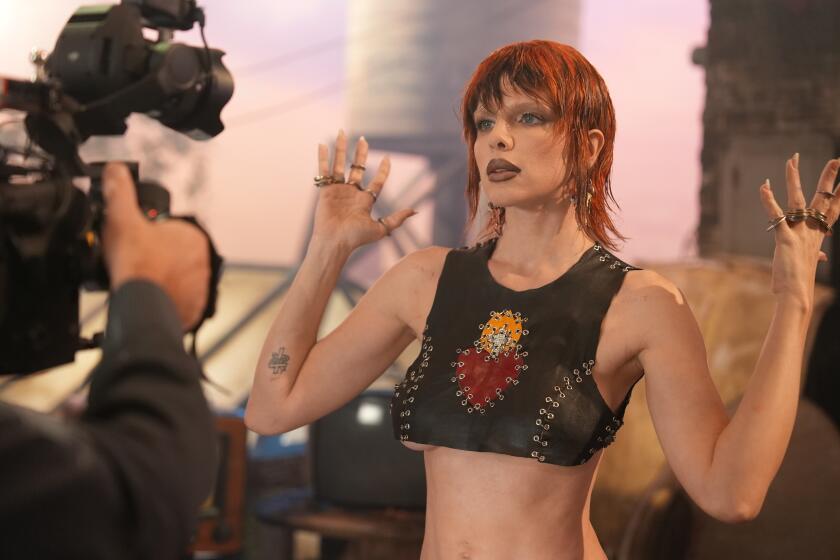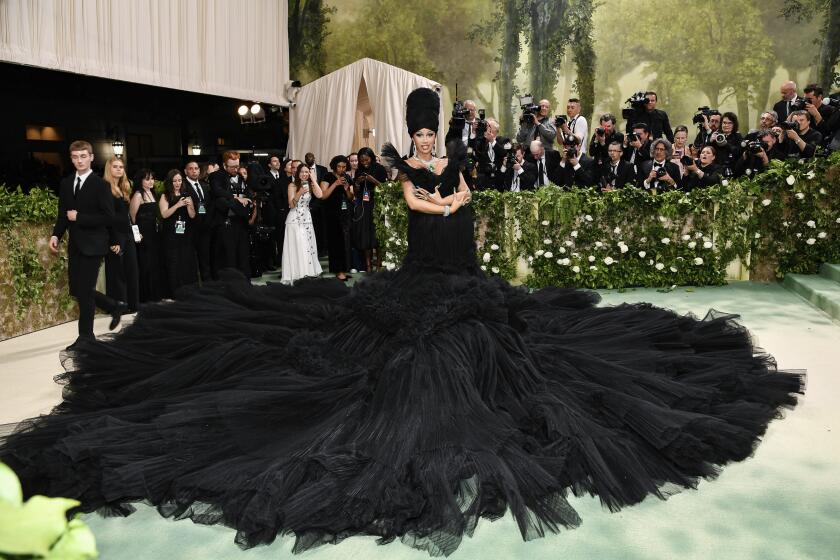The Road to Profit, Paved With Panties
It seems like a license to print money: Stitch together tiny pieces of fabric, pitch it to women as apparel that makes them sexy, mark it up to as much as $80, then watch the cash roll in.
That may explain why so many apparel retailers are hot for the lingerie business.
Gap Inc., not known for sizzling underwear, is adding 30 more GapBody sections to its namesake stores this year -- three times as many as last year -- selling panties, bras and pajamas.
Levi Strauss & Co. of San Francisco, known mainly for its jeans, has just begun delivering its own brand of panties and bras to store shelves. The frill-free products feature jeans-style detailing, such as rivets and contrast stitching.
And Victoria’s Secret, which transformed the retailing of come-hither lingerie two decades ago, is targeting college students with a line of intimate apparel that analysts predict will become its own chain next year.
Retailers are jostling to outdo one another, wooing women of all shapes and ages with lingerie. The $9.1-billion intimate-apparel niche, including loungewear such as negligees and camisoles -- represents almost 10% of total women’s apparel sales nationwide, said Marshal Cohen, chief analyst at NPD Group, a market research firm. Sales of sleepwear are an additional $3.6 billion.
Victoria’s Secret, the dominant player, raked in $4.2 billion last year, 11% more than in 2003 and more than any of Limited Brands Inc.’s other divisions.
Analysts say a variety of factors is helping to drive lingerie sales, including the growing acceptance of innerwear as outerwear.
Stuart Fischoff, professor emeritus at Cal State Los Angeles, who teaches and conducts research about the media’s effect on popular culture, says young consumers take their cues from celebrities, fashion magazines and the media. And television, movies, music, books and advertising are soaked in sex -- whether the racy banter on “Will & Grace” or a Carl’s Jr. commercial featuring a scantily clad Paris Hilton soaping up a Bentley.
“All the women have tattoos on the lower part of their backs and they’re all wearing thongs,” said Fischoff, 65. “The notion of wearing your bra on top of your blouse used to be a sign of Alzheimer’s. Now it’s not a memory defect, it’s being culturally hip.”
Seeking to cash in on an eye-catching trend, Victoria’s Secret and other retailers are selling thongs trimmed with sequins, rhinestones and butterflies from $10 to $80 to teens and young women who wear fancy undies that peek above low-rise jeans or skirts.
“There’s not a big distinction anymore about what you can wear out and what you wear under,” said Monica Mitro, a spokeswoman for Victoria’s Secret.
The trend is not likely to stall anytime soon if Los Angeles trend forecaster Barbara Field’s recent visits to Tokyo are any indication. Teen retailers in the trendsetting city were selling “bra tops” that could be worn under shirts that are partially unbuttoned or that have V-necklines deep enough to display the undergarment -- a style some American women already are sporting.
“Every juniors store had a bra top,” said Fields, who is paid by retailers to spot clothing trends. She has recommended the bra tops to her U.S. clients for next spring.
In the U.S., women typically spend anywhere from $60 to $360 a year on lingerie, much of it bought at discounters such as Wal-Mart Stores Inc., the nation’s largest lingerie seller, said Britt Beemer, chairman of America’s Research Group. But many women spend hundreds more.
Donnell Gilbreath thinks nothing of spending $75 for a bra.
“If I even think something’s getting old, I’m beelining to get more, “ said Gilbreath, 47, a Los Angeles resident who is vice president of a real estate development firm. “Thongs, bikinis and French cut, that’s what I buy. I don’t like that granny panty thing.”
Nothing has titillated the underwear world in the last decade quite like thong underwear, a modified G-string that erased the dreaded visible panty line. More recently, “boy shorts,” ultra-short panties with more rear-end coverage, have helped fuel sales.
Boy shorts are hot at Neiman Marcus Group Inc.’s stores, buyer Ann Cox said, but nothing sizzles like Hanky Panky’s “4811” and “4911,” stretchy $18 lace thongs with a tad more material up the back. Ask an underwear saleswoman about the brand and she’s likely to hook her thumb into her panties and tug up a strip of lace to show that she too wears them.
Cox said Neiman Marcus’ thong business had been slipping until a Wall Street Journal story in the summer of 2004 revealed that actresses Cindy Crawford and Julianne Moore and legions of working women were loyal customers of Hanky Panky.
“I truly believe we sell them to everybody who walks into intimate apparel -- not literally, but almost,” Cox said.
New York-based Hanky Panky said Friday that its revenue had doubled in the last 18 months. Having added 1,000 retail accounts this year, the company is shipping 70,000 thongs a week and expecting annual sales of about $26 million.
After the story was published, one reader reported that he and other men, Journal in hand, went thong shopping.
“My optimism, alas, was short-lived, for after trying on this delicate piece of lace and cotton, my petite wife informed me that she still couldn’t imagine why any woman would want to walk around” wearing an uncomfortable undergarment, the reader wrote. “Looks like the Hanky Panky product will now join the other unused gifts at the back of the lingerie drawer.”
Fischoff, the Cal State professor, blames the visible thong phenomenon partly on Monica Lewinsky, the intern who infamously showed off her underwear in the White House to then-President Bill Clinton.
“It notoriously popularized that undergarment so people could feel a little wickedly playful when they wore it,” Fischoff said. “When you have a president and a playmate involved with thongs, that takes on a cachet in the popular culture. So people are going to find it more sexually attractive to see it on their girlfriend, or to wear for their boyfriend, than it would have been beforehand.”
It all began with Frederick’s of Hollywood, which opened its first store on Hollywood Boulevard in 1946, selling black lingerie. When the company tried to move into malls in the early 1960s, it struggled to get prime locations and was routinely pushed into less-trafficked corners, spokeswoman Jennifer Lowitz said.
“I think it was because lingerie was still seen as still a little risque and too sexy for the average mall shopper,” Lowitz said.
“Vickie’s,” as some industry insiders call Victoria’s Secret, changed all that.
The retailer, which was purchased by Limited in 1982, convinced American women that sexy lingerie suited the girl next door, Cohen of NPD Group said. They also got help from Sara Lee Corp. when its Wonderbra began showing up on billboards, making bulging bosoms part of the American landscape, said Ilse Metchek, executive director of the California Fashion Assn. in Los Angeles.
Now Victoria’s Secret, which has more than 1,100 stores, maintains a presence in small American towns.
Fischoff said he was surprised at the attention that Victoria’s Secret attracted in Carbondale, Ill., a small college town that boasts about 50 churches, a synagogue and a mosque.
It’s “one of the most important places at the mall,” said Fischoff, who bought a house in Carbondale after retiring in April.
“There’s something rumbling across America that people aren’t paying enough attention to,” he said. “It’s a celebration of sensation.”
For some businesses, it has been a celebration of sales. Intimate-apparel sales rose about 8% in four of the last five years, Cohen said, but growth slowed last year as women spent more on other items. Specialty stores increasingly have pushed into the lingerie business, once the domain of department stores.
As consumers became more confident about lingerie purchases, plus-size women joined their ranks.
Rapper and actress Queen Latifah partnered with a division of apparel giant VF Corp. two years ago to launch an intimate-apparel line for “curvaceous” women. VF Intimates struck its first deal with Wal-Mart, which began selling bras -- the “uplift,” a “side shaper,” the “minimizer” and a “back smoother” -- for $12.87, along with “tummy smoothing” panties, said Anne Jardine, VF’s vice president of new business development.
The company has since expanded its distribution to Sears Holding Corp.’s Kmart stores and other discounters.
It also has more products, including a “tummy smoother thong” and a strapless bra that features “elastomeric” bonding, Jardine said.
Retailers also have increasingly set their sights on baby boomers. Chico’s FAS Inc. last year launched a chain to sell lingerie to middle-aged women.
This, of course, presents some challenges.
“Some people don’t like to show their arms, some want to cover their butt, some don’t like their knees,” said Pat Murphy Kerstein, chief merchandising officer for Soma by Chico’s.
Soft lighting helps.
So when Soma by Chico’s launched last year, the company installed “subdued” lighting in the dressing rooms, Kerstein said. It also placed vanities in front of the mirrors.
“You can view yourself from your waist up so you’re not concentrating on your entire reflection,” Kerstein said.






